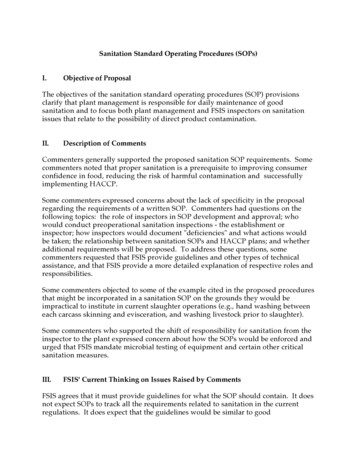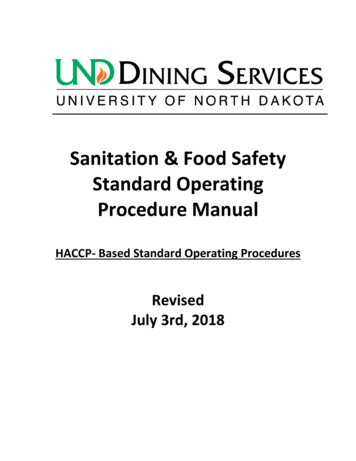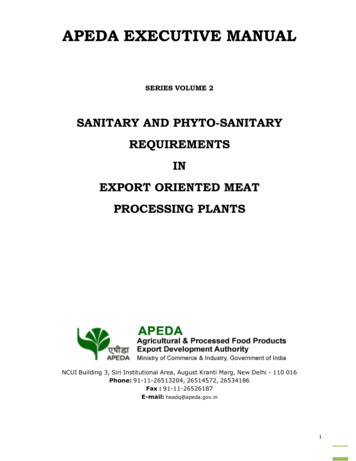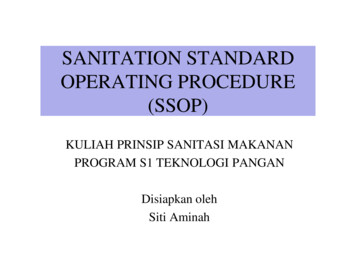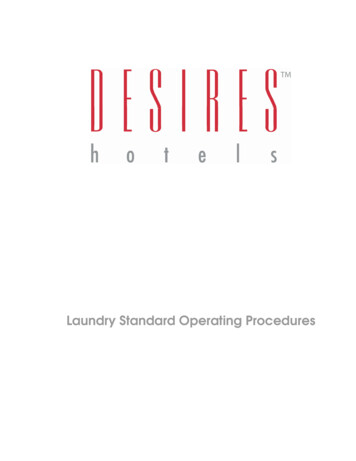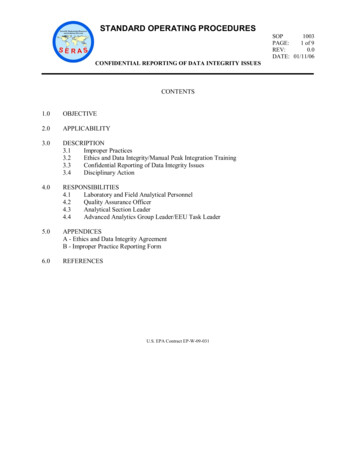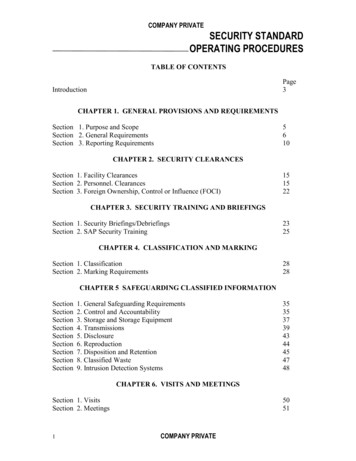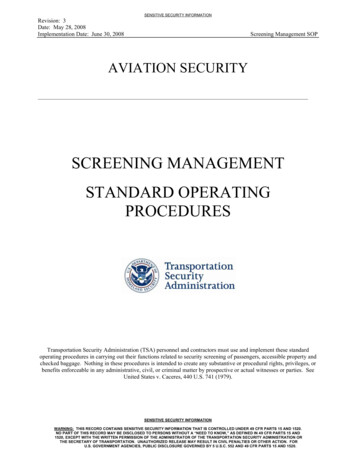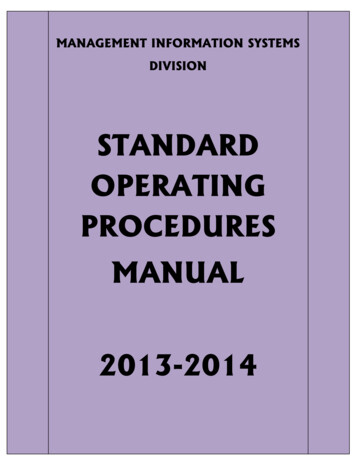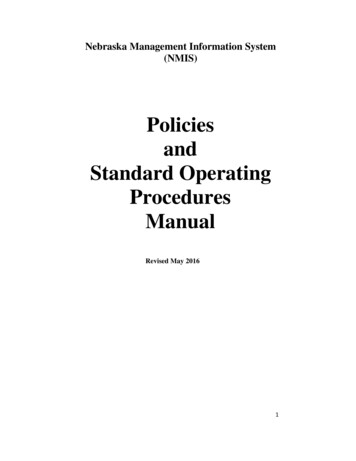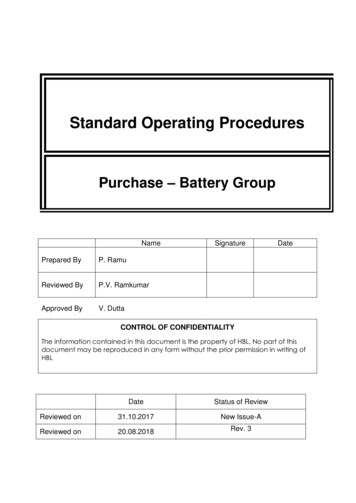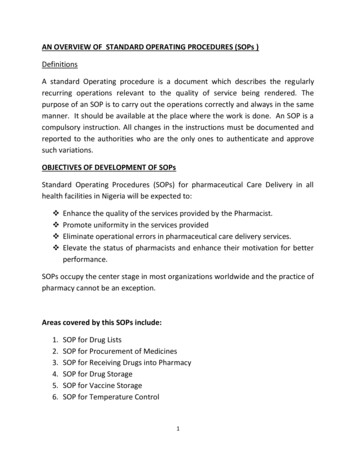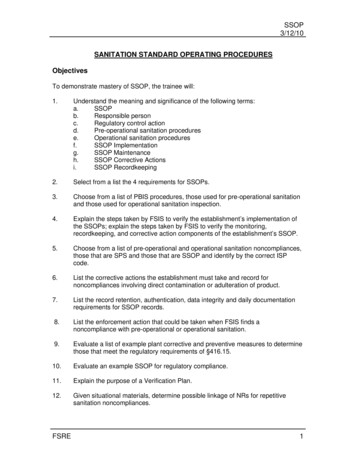
Transcription
SSOP3/12/10SANITATION STANDARD OPERATING PROCEDURESObjectivesTo demonstrate mastery of SSOP, the trainee will:1.Understand the meaning and significance of the following terms:a.SSOPb.Responsible personc.Regulatory control actiond.Pre-operational sanitation procedurese.Operational sanitation proceduresf.SSOP Implementationg.SSOP Maintenanceh.SSOP Corrective Actionsi.SSOP Recordkeeping2.Select from a list the 4 requirements for SSOPs.3.Choose from a list of PBIS procedures, those used for pre-operational sanitationand those used for operational sanitation inspection.4.Explain the steps taken by FSIS to verify the establishment’s implementation ofthe SSOPs; explain the steps taken by FSIS to verify the monitoring,recordkeeping, and corrective action components of the establishment’s SSOP.5.Choose from a list of pre-operational and operational sanitation noncompliances,those that are SPS and those that are SSOP and identify by the correct ISPcode.6.List the corrective actions the establishment must take and record fornoncompliances involving direct contamination or adulteration of product.7.List the record retention, authentication, data integrity and daily documentationrequirements for SSOP records.8.List the enforcement action that could be taken when FSIS finds anoncompliance with pre-operational or operational sanitation.9.Evaluate a list of example plant corrective and preventive measures to determinethose that meet the regulatory requirements of §416.15.10.Evaluate an example SSOP for regulatory compliance.11.Explain the purpose of a Verification Plan.12.Given situational materials, determine possible linkage of NRs for repetitivesanitation noncompliances.FSRE1
SSOP3/12/10SANITATION STANDARD OPERATING PROCEDURESReference: 9 CFR 416.11 through 416.17§416.11 General RulesEach official establishment shall develop, implement, and maintain writtenstandard operating procedures for sanitation (Sanitation SOPs) in accordancewith the requirements of this part.Sanitation Standard Operating Procedures (SSOPs) are written procedures thatan establishment develops and implements to prevent direct contamination oradulteration of product. The establishment must also maintain daily recordssufficient to document the implementation and monitoring of the SSOPs and anycorrective action taken. The establishment is required to maintain these writtenprocedures on file, and they must be available to FSIS upon request. It is theestablishment’s responsibility to implement the procedures as they are written inthe SSOPs. If the establishment or FSIS determines that the SSOPs fail toprevent direct contamination or adulteration of product, the establishment mustimplement corrective actions that include the appropriate disposition of product,restoration of sanitary conditions, and measures to prevent recurrence.§416.12 Development of SSOPs(a) The Sanitation SOPs shall describe all procedures an official establishmentwill conduct daily, before and during operations, sufficient to prevent directcontamination or adulteration of product(s).(b) The Sanitation SOPs shall be signed and dated by the individual with overallauthority on-site or a higher level official of the establishment. This signatureshall signify that the establishment will implement the Sanitation SOPs asspecified and will maintain the Sanitation SOPs in accordance with therequirements of this part. The Sanitation SOPs shall be signed and datedupon initially implementing the Sanitation SOPs and upon any modification tothe Sanitation SOPs.(c) Procedures in the Sanitation SOPs that are to be conducted prior tooperations shall be identified as such, and shall address, at a minimum, thecleaning of food contact surfaces of facilities, equipment, and utensils.(d) The Sanitation SOPs shall specify the frequency with which each procedurein the Sanitation SOPs is to be conducted and identify the establishmentemployee(s) responsible for the implementation and maintenance of suchprocedure(s).FSRE2
SSOP3/12/10Establishment ResponsibilitiesThe establishment has the responsibility to develop written SSOPs that containprocedures that the establishment will implement to prevent direct contaminationor adulteration of product. It is also required that SSOPs describe the proceduresthat the establishment will take to prevent direct contamination or adulteration ofproduct. The establishment and inspection personnel should understand thatthere are not separate SSOPs for different operations or different shifts. TheSSOPs cover the entire establishment and all shifts of operation.These written procedures must: Contain all the procedures the establishment will conduct daily, before andduring operation. Identify the procedures to be conducted prior to operations (pre-op) andaddress, at a minimum, the cleaning of food contact surfaces of facilities,equipment, and utensils. Specify the frequency with which each procedure in the SSOPs is to beconducted and identify the establishment employee or positionresponsible for the implementation and maintenance of the procedures. Be signed and dated by the individual with overall authority on-site or ahigher-level official of the establishment. This signature signifies that theestablishment will implement the SSOPs as written and will maintain theSSOPs in accordance with the requirements of this part.Inspection Verification for the SSOP DesignAll USDA inspected establishments must have an SSOP that meets thedevelopment (basic design) requirements in § 416.12 before a Grant of FederalInspection is given. The basic (01A01) procedure to verify that the SSOP wasdesigned properly was performed when the establishment began operations. The01A01 procedure is also performed annually near the end of the January andanytime there are major changes to the establishment’s existing SSOP.When you perform this procedure, you will complete FSIS Form 5000-2,Sanitation SOP - Basic Compliance Checklist and record the procedure as anunscheduled 01A01. A blank copy of the Form 5000-2 is included in yourhandout. This is a very simple form giving some basic questions to consider inthe evaluation of the establishment’s SSOP. The first blocks on the form ask forthe establishment’s name and number, and the date the SSOPs wereimplemented. If all the required components are present in the establishment’sSSOP, there should be no checkmarks (i.e., no "yes" responses to anyquestions) on the form when you have completed it. Add procedure 01A01 to theFSRE3
SSOP3/12/10PBIS "Procedure Results" screen and select "a” for performed. The completedform is then filed in the government office file.If you determine that the SSOP does not meet the regulatory requirementsspecified in §416.12, contact the IIC or the District Office through supervisorychannels. The District Office will provide direction as to whether you shouldinstitute an enforcement action specified in 9 CFR 500.For you to effectively verify the establishment’s SSOP, you need to understandthe SSOP regulations (§416.11 - §416.16) and be familiar with the current SSOP.FSIS Directive 5000.1, Rev. 3 discusses the different roles and responsibilities ofFSIS personnel.FSRE4
SSOP3/12/10WORKSHOP I - Identifying the Elements of the Basic ComplianceRequirements of the SSOP.Carefully read the Sample SSOP. Evaluate the SSOP using the FSIS Form5000-2 for compliance with regulatory requirements. After you have evaluatedthe SSOP, list any failures to comply.BEEF SLAUGHTER ESTABLISHMENT 38M—SSOPOwner – Joe GreenThis SSOP is for Beef Slaughter Establishment 38M and becomes effective onJanuary 28, 1998.Pre-operationalAll food contact surfaces of the facility, equipment, and utensils on the kill floorwill be cleaned daily after production by rinsing, soaping, and sanitizing.All cleaning will be monitored daily by Joe Green before production begins thenext day.Records will be kept on Form Pre-Op I by Joe Green.OperationalEvery day all equipment and surfaces on the kill floor will be kept as sanitary asnecessary to prevent contamination or adulteration of the carcasses.Every day all employees will follow hygienic practices to keep themselves fromcontaminating or adulterating carcasses.These actions will be monitored by Joe Green once each day.Records of this monitoring will be kept on Form Ops I by Joe Green.Corrective actions taken during pre-operational sanitation inspection or duringoperations will be written on the back of the Form Pre-Op I or Form Ops I asnecessary.(Signature and date of 1/25/98)Joe GreenModification Log1.2.(signature and date of Joe Green, 12/11/98)(signature and date of Joe Green, 6/17/99)Are there any failures to comply?FSRE5
SSOP3/12/10U.S. DEPARTMENT OF AGRICULTUREFOOD SAFETY AND INSPECTION SERVICESANITATION SOP'S -- BASIC COMPLIANCE CHECKLISTESTABLISHMENT NAMEESTABLISHMENT NO.IMPLEMENTATION DATEUse this checklist to document findings of noncompliance with the requirements set out in FSIS Directive 5000.1, Part Three, Paragraph II.B.3. DATEDSIGNATURE2.RECORDKEEPING1. SANITATION SOP'SREQUIREMENTYES( )The establishment does not have written SanitationSOP’s that describe the procedures the establishmentconducts daily to prevent direct contamination oradulteration of product(s) (§416.12(a)).The Sanitation SOP’s do not identify which of theprocedures are pre-operational procedures(§416.12(c)).The pre-operational procedures do not address (at aminimum) the cleaning of food contact surfaces offacilities, equipment, and utensils (§416.12 (c)).The Sanitation SOP’s do not specify the frequency withwhich the establishment will conduct each procedure(§416.12 (d)).The Sanitation SOP’s do not identify the establishmentemployee or employees responsible for implementingand maintaining specified procedures (§416.12 (d)).The establishment does not have identified recordsthat, on a daily basis, document implementation andmonitoring of the Sanitation SOP’s and any correctiveactions taken (§416.16(a)).The individual with overall authority on-site or a higherlevel official of the establishment did not sign and datethe Sanitation SOP’s(1) upon initial implementation, or(2) upon a modification(§416.12 (d)).FSIS FORM 5000-2 (9/97)FSRE6
SSOP3/12/10SSOP Verification ProceduresThere are two SSOP procedures that you will use for pre-operational sanitationverification (01B01 and 01B02) and two SSOP procedures that you will use foroperational sanitation verification (01C01 and 01C02). You perform theseprocedures to verify that the establishment is meeting the SSOP regulatoryrequirements. Regardless of whether you are performing the recordkeepingprocedures or the review and observation procedures, you are verifying that thesame regulatory requirements are met.Table 1Verification iew & Observation01B0101B02You review records ofpreoperationalprocedures01C01Operational ProceduresYou review records ofoperational proceduresYou observe theestablishment conduct itspreoperational activities,perform an independentexamination and compare theresults.01C02You observe theestablishment conduct itsoperational activities, performan independent examinationand compare the results.Those requirements are:a.Implementation of SSOP (monitoring) (§416.13);b.Maintenance of SSOP (effectiveness) (§416.14);c.SSOP corrective actions (§416.15); andd.SSOP recordkeeping (§416.16).01B01 ProcedureThe 01B01 SSOP procedure is the pre-operational recordkeeping procedure.This recordkeeping procedure instructs you to review the daily documentation ofthe establishment’s implementation and monitoring of the SSOP pre-operationalprocedures and any required corrective actions.FSRE7
SSOP3/12/10You should review the SSOP to become familiar with the pre-operationalsanitation procedures. When you perform the 01B01 procedure, you arereviewing the daily pre-operational sanitation records. This procedure should beperformed to verify that the establishment has daily records that demonstrate theestablishment has implemented the pre-operational procedures, monitored thoseprocedures, and taken immediate action when necessary. For instance, whenthe establishment finds a contaminated food contact surface (foreign material,residue from previous day’s product, etc.) during pre-operational inspection, itimplements its procedure by cleaning the surface before product passes over thesurface.You should review the SSOP prior to beginning the review of the records toensure that it has not been modified since you last reviewed it and that you arefamiliar with the pre-operational sanitation procedures. When performing therecordkeeping procedure for pre-operational sanitation, you should be reviewingthe records to determine if the establishment is complying with the regulatoryrequirements.You should look at the records to verify that the monitoring was conducted dailyprior to the start of operations. You should review the records to verify that eachtime the establishment documented that food contact surfaces were foundunclean that the SSOP was implemented effectively. In most cases, product isnot coming into contact with equipment surfaces prior to the start of operations,nevertheless, if the establishment found contaminated product, verify that it hasdocumented corrective actions that meet the requirements of §416.15. In suchsituations, you should ensure that the corrective actions implemented anddocumented are adequate to: 1) ensure appropriate disposition of product; 2)restore sanitary conditions; and 3) prevent recurrence. While reviewing the preoperational sanitation records, you should also verify that the establishmentemployee responsible for the implementation or monitoring has authenticated therecords with initials and date.If the establishment has not recorded its monitoring activities, has not recordedcorrective actions when product contamination is observed, or has not initialedand dated the daily record for authentication, there is noncompliance.01B02 Procedure
standard operating procedures for sanitation (Sanitation SOPs) in accordance . with the requirements of this part. Sanitation Standard Operating Procedures (SSOPs) are written procedures that an establishment develops and implements to prevent direct contamination or adulteration of product. The establishment must also maintain daily records
